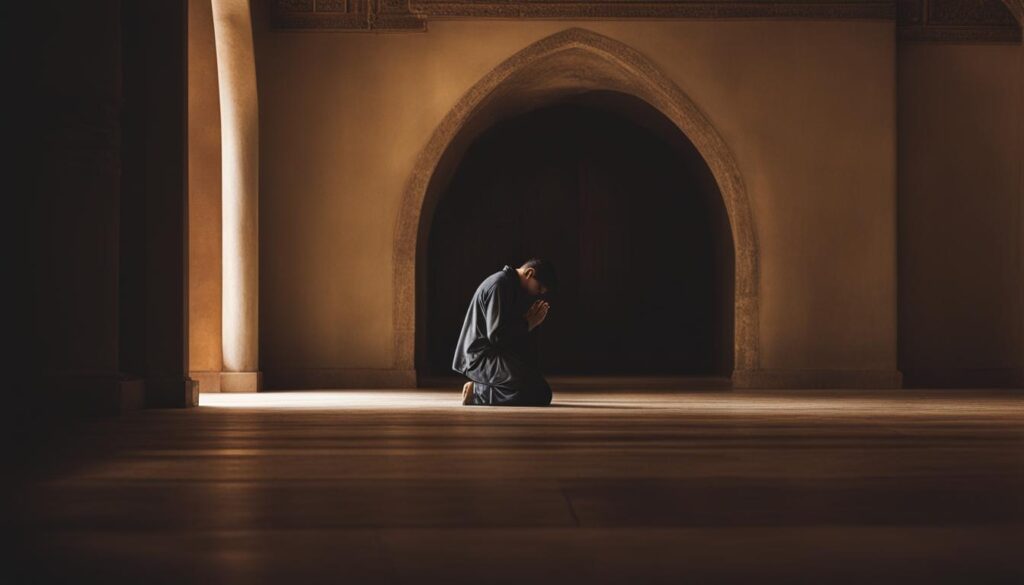Prayer is a fundamental aspect of Catholic spirituality. It is a means of communication with God, a way to seek His guidance, and a path to deepen our relationship with Him. In this comprehensive guide, we will explore the different techniques and practices of Catholic prayer, empowering you to develop a rich and transformative prayer life.
Whether you are new to Catholicism or seeking to deepen your existing prayer practice, this guide will equip you with the knowledge and tools to pray Catholic-style with confidence and sincerity. From vocal prayer to meditation and contemplative prayer, each form offers a unique way to connect with God and experience His presence in your life.
Throughout this guide, we will also delve into traditional devotions such as the Rosary and the Stations of the Cross, as well as the inspirational lives of the saints. These devotions and examples of holiness can serve as powerful sources of inspiration and guidance in your own prayer journey.
By approaching prayer with a sincere and open heart, you can cultivate a deep sense of trust in God and witness the transformative power of prayer in your daily life. Let us embark together on this spiritual journey and embrace the beauty and richness of Catholic prayer.
Key Takeaways:
- Catholic prayer is both an activity and a way of life
- Vocal prayer, meditation, and contemplative prayer are different forms of Catholic prayer
- The Rosary and the Stations of the Cross are traditional Catholic devotions
- The lives of the saints can offer inspiration and guidance in prayer
- Approaching prayer with sincerity and an open heart is essential
Vocal Prayer: Giving Voice to Your Heart
Vocal prayer is an essential aspect of Catholic prayer rituals, enabling believers to give voice to their deepest thoughts, desires, and gratitude. It serves as a way to express what is in our hearts and souls, fostering a deeper connection with God. Whether it’s a simple phrase like “Thank you, God” or the recitation of formal prayers like the Sign of the Cross or the Hail Mary, vocal prayer allows Catholics to communicate directly with the Divine.
Traditional prayers hold a special place in Catholic worship, offering a sense of unity and continuity with the faithful throughout history. The Our Father, Hail Mary, and Sign of the Cross are among the essential prayers for Catholics. These prayers serve as foundational pillars, grounding individuals in their faith and serving as a constant source of guidance and solace.
Catholics also engage in vocal prayer as a community, finding strength and inspiration in group settings. The Mass, the central act of worship in Catholicism, involves collective vocal prayer, as the faithful come together to praise God, offer their intentions, and share in the Eucharist. Other group prayers, such as the Rosary, provide a powerful opportunity for communal devotion, fostering a sense of unity and shared spirituality.
| Essential Prayers for Catholics | Description |
|---|---|
| The Our Father | A prayer taught by Jesus himself, it encompasses the core teachings of Christianity. |
| The Hail Mary | A prayer that honors the Virgin Mary, seeking her intercession and protection. |
| The Sign of the Cross | A fundamental gesture of faith, invoking the Holy Trinity and seeking divine blessing. |
Vocal prayer is not simply a series of gestures or words; it is an expression of a living faith. By giving voice to our deepest sentiments and desires, we open ourselves to the transformative power of prayer and invite God into our lives.
Catholic Prayer: Embracing the Power of Meditation
When it comes to Catholic prayer, meditation is a powerful practice that allows believers to reflect on the presence of God in their lives. Through focused contemplation, individuals can deepen their spiritual connection and experience a profound sense of union with the divine.
Meditation can take various forms in the Catholic tradition. One approach is to use Scripture as a guide, allowing the words of the Bible to guide thoughts and reflections. This practice helps believers engage deeply with the teachings and stories of Jesus, finding inspiration and guidance in their own spiritual journey.
Another method of meditation in the Catholic faith involves using traditional prayers or religious images as focal points during quiet reflection. By fixing their attention on these sacred symbols, individuals can enter into a deeper communion with God, fostering a sense of peace and tranquility in their hearts.
“Meditation is the door to the inner sanctuary of the heart where we meet the Divine Presence.”
– Saint Teresa of Avila
| Benefits of Catholic Meditation | Examples |
|---|---|
| Deepens spiritual awareness | Reflecting on the life of Christ |
| Fosters inner peace and tranquility | Meditating on sacred images |
| Enhances connection with God | Using Scripture as a guide |
| Promotes self-reflection and growth | Engaging in contemplative silence |
Through regular meditation, Catholics can cultivate a deeper awareness of God’s presence and strengthen their relationship with the divine. It is a practice that encourages spiritual growth, self-reflection, and inner peace, enabling individuals to navigate life’s challenges with a sense of purpose and divine guidance.
Contemplative Prayer: Resting in God’s Presence
Contemplative prayer, also known as silent prayer or the prayer of the heart, is a practice that allows individuals to rest in the presence of God in wordless silence. It is a way to connect deeply with God and experience His love on a personal level. Through contemplative prayer, Catholics seek to deepen their prayer life and enter into a state of union with God.
“In contemplative prayer, we are not seeking to understand or analyze, but rather to simply be in God’s presence,” says Father John, a renowned Catholic spiritual director. “It is in this stillness and silence that we can truly encounter the divine.”
During contemplative prayer, individuals set aside distractions and external stimuli, creating a space for God’s presence to manifest. It is a time of deep listening and receptivity, allowing God to speak to our hearts in ways beyond words. Through this practice, Catholics can experience a profound sense of peace, clarity, and spiritual renewal.
The Benefits of Contemplative Prayer
Contemplative prayer offers a range of benefits for those seeking to deepen their Catholic prayer life. By regularly engaging in this practice, individuals can:
- Experience a deeper connection with God
- Strengthen their relationship with Christ
- Find solace in times of turmoil or uncertainty
- Gain insights and guidance from the Holy Spirit
- Develop a greater sense of inner peace and calm
Contemplative prayer is a way to cultivate a sense of intimacy with God and nourish the soul. It is a powerful and transformative practice that can deepen one’s faith and bring about profound spiritual growth.
| Key Elements of Contemplative Prayer | Practical Tips for Contemplative Prayer |
|---|---|
|
|

Whether you are just beginning to explore contemplative prayer or have been practicing it for years, it is a profound way to deepen your Catholic prayer life and draw closer to God. As you enter into the silence and stillness, may you find peace, clarity, and a profound sense of God’s love and presence.
Rosary: A Traditional Catholic Devotion
The Rosary is a cherished and traditional Catholic devotion that holds a special place in the hearts of believers. It is a prayerful practice that involves meditating on the life of Jesus and Mary while using a string of beads as a guide. The Rosary brings Catholics closer to God, deepens their faith, and seeks intercession from the Blessed Virgin Mary.
The structure of the Rosary consists of four sets of Mysteries: the Joyful, the Sorrowful, the Glorious, and the Luminous. Each set focuses on key moments in the lives of Jesus and Mary, inviting believers to reflect on their significance and draw spiritual inspiration.
Praying the Rosary can be done individually or in a group setting. In communal prayer, Catholics come together to recite the prayers and share in the meditative journey. This shared experience strengthens the bond of community and provides a sense of unity in faith.
Benefits of Praying the Rosary
“The holy Rosary is a powerful weapon. Use it with confidence and you’ll be amazed at the results.” – St. Josemaría Escrivá
Praying the Rosary offers a multitude of benefits for believers. It fosters a deeper connection with God and the Blessed Virgin Mary, allowing individuals to seek their intercession and guidance. The repetitive prayers of the Rosary create a sense of peace and tranquility, providing solace in times of distress and anxiety. It also aids in meditation and contemplation, allowing for a focused and reflective prayer experience.
Additionally, the Rosary cultivates virtues such as humility, patience, and perseverance. It strengthens faith and trust in God’s plan, as believers reflect on the mysteries of salvation woven into the life of Jesus. The Rosary is a tangible reminder of the power of prayer and brings forth spiritual blessings and graces.
| Benefits of Praying the Rosary | Keywords |
|---|---|
| Strengthens faith and trust in God’s plan | faith, trust, God’s plan |
| Fosters a deeper connection with God and the Blessed Virgin Mary | connection, God, Blessed Virgin Mary |
| Cultivates virtues such as humility, patience, and perseverance | virtues, humility, patience, perseverance |
| Provides solace in times of distress and anxiety | solace, distress, anxiety |
| Aids in meditation and contemplation | meditation, contemplation |
Praying the Rosary is a powerful and beloved practice that allows Catholics to journey deeper into their faith, seeking the blessings and intercession of the Blessed Virgin Mary while meditating on the life of Jesus. It offers a multitude of spiritual benefits and strengthens the bond with God and the faith community.
Sacramentals: Symbolic Aids in Prayer
Sacramentals are an integral part of Catholic prayer practices, providing tangible symbols that assist in directing our minds and hearts towards the sacred. These sacred objects or activities help us deepen our participation in the sacraments and enhance our spiritual practice. Through the use of sacramentals, we can create a physical connection to our faith and foster a sense of reverence and devotion.
Examples of sacramentals include holy water, which serves as a reminder of our baptism and the cleansing of sins. Crucifixes and medals help us contemplate the sacrifice of Christ and the intercession of the saints. Scapulas, worn around the neck, are a sign of our devotion to the Blessed Virgin Mary and a reminder of her protection. By incorporating these sacramentals into our prayer routines, we can engage our senses and deepen our spiritual experience.
“Sacramentals remind us of the presence of the sacred in our daily lives and serve as tangible reminders of our faith.”
Furthermore, sacramentals can act as visual aids that assist us in focusing our thoughts and intentions during prayer. For example, the use of sacred oils during the Anointing of the Sick reminds us of God’s healing grace and strengthens our trust in His providence. The presence of crucifixes in our homes or religious spaces serves as a visual reminder of Christ’s love and sacrifice. These physical symbols help create a sacred atmosphere and facilitate a deeper connection with God.
Table: Examples of Sacramentals
| Sacramental | Meaning/Function |
|---|---|
| Holy Water | Reminds us of baptism and the cleansing of sins |
| Crucifix/Medals | Contemplation of Christ’s sacrifice and intercession of the saints |
| Scapulas | Devotion to the Blessed Virgin Mary and her protection |
| Sacred Oils | Symbol of healing and God’s grace |
By embracing the use of sacramentals in our prayer life, we can enrich our spiritual journey and draw closer to God. These symbolic aids serve as reminders of the presence of the sacred in our daily lives, guiding us towards a deeper understanding of our faith and a more meaningful connection with the divine.

Stations of the Cross: A Pilgrimage Within
The Stations of the Cross allow Catholics to spiritually journey with Jesus on His way to Calvary. It is a prayerful devotion that involves reflecting on each station and meditating on Jesus’ suffering and sacrifice. This powerful practice helps Catholics enter into the depth of Christ’s love for humanity and strengthens their faith.
The Stations of the Cross can be prayed individually or in a church setting. It is common to find stations depicted on the walls of Catholic churches, where believers can physically move from one station to another, pausing to reflect and pray at each one. The devotion typically consists of 14 stations, beginning with Jesus’ condemnation and ending with His burial.
The Stations of the Cross help Catholics contemplate the immense love and sacrifice Jesus made for us. Through praying the stations, we can deepen our understanding of Christ’s journey to the cross and find solace in His presence during our own struggles.
During the Stations of the Cross, Catholics are invited to engage their senses and emotions, imagining the scenes and reflecting on Jesus’ suffering. This devotion serves as a reminder of the immense love and sacrifice Jesus made for humanity. It is a way to connect deeply with the passion of Christ and to seek His intercession and guidance in our own lives.

Table: Stations of the Cross
| Station | Description |
|---|---|
| Station 1 | Jesus is condemned to death |
| Station 2 | Jesus carries His cross |
| Station 3 | Jesus falls the first time |
| Station 4 | Jesus meets His mother |
| Station 5 | Simon of Cyrene helps Jesus carry the cross |
| Station 6 | Veronica wipes the face of Jesus |
| Station 7 | Jesus falls the second time |
| Station 8 | Jesus meets the women of Jerusalem |
| Station 9 | Jesus falls the third time |
| Station 10 | Jesus is stripped of His garments |
| Station 11 | Jesus is nailed to the cross |
| Station 12 | Jesus dies on the cross |
| Station 13 | Jesus is taken down from the cross |
| Station 14 | Jesus is placed in the tomb |
Lives of the Saints: Inspiration for Holiness
The lives of the saints serve as powerful examples of holiness and provide inspiration for our own spiritual journeys. Their stories show us what it means to live a life dedicated to God and the transformative power of prayer. By reading about and reflecting upon the lives of the saints, we can learn valuable lessons on how to deepen our Catholic prayer practices and grow in our relationship with God.
The saints exemplify different paths to holiness, each with their own unique struggles and triumphs. For example, Saint Teresa of Avila’s life teaches us about the importance of contemplative prayer and seeking union with God. Her writings, such as “The Interior Castle,” provide insights into the depths of the spiritual life.
Similarly, Saint Francis of Assisi’s life shows us the value of simplicity and humility in prayer. His devotion to God and love for all of creation serve as reminders to approach prayer with a childlike spirit and gratitude.

Whether it is the courage of Saint Joan of Arc, the compassion of Saint Mother Teresa, or the intellectual pursuit of truth by Saint Thomas Aquinas, the lives of the saints offer us a diverse range of role models. Their stories inspire us to deepen our Catholic prayer practices and strive for greater holiness in our own lives.
Table: Saints and Lessons for Prayer Life
| Saint | Lesson for Prayer Life |
|---|---|
| Saint Teresa of Avila | Embrace contemplative prayer and seek union with God. |
| Saint Francis of Assisi | Approach prayer with simplicity, humility, and gratitude. |
| Saint Joan of Arc | Find courage and strength through prayer and unwavering faith. |
| Saint Mother Teresa | Show compassion and love through prayerful service to others. |
| Saint Thomas Aquinas | Pursue intellectual depth and seek truth through prayer and study. |
As we study the lives of the saints and learn from their examples, we can deepen our Catholic prayer practices and strengthen our connection with God. They remind us that holiness is attainable and that prayer is the key to cultivating a rich spiritual life. Through their intercession and guidance, we are encouraged to persevere in our own prayer journeys, seeking to align our hearts with the will of God and grow in holiness.
Asking for Guidance: Praying to the Holy Spirit
When it comes to deepening our Catholic prayer life, seeking guidance from the Holy Spirit is essential. By praying to the Holy Spirit, we acknowledge our need for His guidance and invite Him into our hearts. This connection with the Holy Spirit can bring us closer to God and help us discern His will for our lives.
Opening our hearts to the Holy Spirit’s work can lead to transformation and growth. The Holy Spirit is our advocate, comforter, and guide. He can enlighten our minds, strengthen our faith, and provide the wisdom we need to navigate life’s challenges. Whether it’s making an important decision, finding peace in times of turmoil, or simply seeking clarity in our prayer life, the Holy Spirit is there to guide us.
Asking for guidance from the Holy Spirit can be done through heartfelt prayers, such as the “Come, Holy Spirit” prayer or simply speaking to Him in our own words. The key is to approach this prayer with a sincere and open heart, trusting in the Holy Spirit’s love and guidance. Through this practice, we can deepen our relationship with God and experience His transformative power in our lives.

Practical Tips for Praying to the Holy Spirit
Here are some practical tips to enhance your experience of praying to the Holy Spirit:
- Find a quiet and comfortable place where you can focus on your prayer.
- Begin by stilling your mind and heart, allowing yourself to be present in the moment.
- Invite the Holy Spirit to come into your heart and guide you.
- Express your desires, concerns, and questions to the Holy Spirit, knowing that He is listening.
- Be open to receiving His guidance and trust in His divine wisdom.
- Take time to listen in silence, allowing the Holy Spirit to speak to your heart.
- Thank the Holy Spirit for His presence and guidance in your life.
“Come, Holy Spirit, fill the hearts of your faithful and kindle in them the fire of your love.”
By regularly praying to the Holy Spirit and seeking His guidance, we can cultivate a deeper connection with God and experience His transformative power in our lives. The Holy Spirit is always ready to assist and guide us, leading us on the path of holiness and bringing us closer to the heart of our Heavenly Father.
Praying Constantly: Bringing God into Every Moment
Praying constantly is a fundamental aspect of Catholic prayer, as it involves maintaining a continuous connection with God throughout the day. It goes beyond formal prayer sessions and invites us to bring God into every moment of our lives. By developing a habit of speaking to God, being constantly aware of His presence, and cultivating a spirit of gratitude and surrender, we can deepen our relationship with Him.
Step-by-step Catholic prayer helps us integrate prayer into our daily routines. We can start by dedicating specific times during the day for prayer, whether it’s in the morning, before meals, or before going to bed. During these times, we can recite standard prayers like the Sign of the Cross, the Our Father, or the Hail Mary. Gradually, we can expand our prayer practice by incorporating moments of silence, reflection, and spontaneous communication with God.
Connecting with God through Catholic prayer also means being mindful of His presence in our everyday activities. We can turn mundane tasks into opportunities for prayer by offering them up to God and seeking His guidance and blessing. Whether we are working, studying, or spending time with loved ones, we can remember to invite God into those moments and seek His grace and guidance.
| Benefits of Praying Constantly | Examples of Praying Constantly |
|---|---|
|
|
Praying constantly is not about reciting words mechanically, but about fostering a genuine connection with God. It is a way to surrender ourselves to His will, seek His guidance, and grow in holiness. By incorporating step-by-step Catholic prayer into our daily lives and always being aware of God’s presence, we can experience the transformative power of constant prayer.
Feelings in Prayer: Natural and Spiritual
In the practice of Catholic prayer, feelings play a significant role in our spiritual journey. While natural feelings such as feeling special or feeling good about oneself are not the ultimate goal of prayer, they can arise as a result of our engagement with the divine. However, it is important to remember that God’s graces work silently in the soul, unseen by the natural senses.
When we approach prayer with a sincere and open heart, we may experience spiritual feelings that indicate the presence of God’s grace. These spiritual feelings can include compunction, gratitude, and joy. Compunction is a feeling of remorse or regret for sins, leading us to seek forgiveness and reconciliation with God. Gratitude arises from recognizing God’s blessings and goodness in our lives, prompting us to offer thanks. Joy flows from the awareness of God’s love and presence, filling our hearts with an abiding sense of contentment and peace.
While we should not solely rely on our feelings as a measure of our spiritual progress, they can serve as important markers along our prayer journey. By cultivating a prayerful heart, we create a space within ourselves to experience the transformative power of God’s grace and deepen our Catholic prayer life.
Table: Natural and Spiritual Feelings in Prayer
| Types of Feelings | Description |
|---|---|
| Natural Feelings | Feelings such as feeling special or feeling good about oneself that may arise during prayer but are not the ultimate goal. |
| Spiritual Feelings | Feelings that emerge from a prayerful heart, indicating the presence of God’s grace, such as compunction, gratitude, and joy. |
By recognizing and discerning these feelings, we can navigate our prayer life with greater awareness and understanding. It is through prayer that we open ourselves to a deeper relationship with God, allowing His grace to transform us from within.
Conclusion
Prayer is an essential aspect of Catholic spirituality. It is a way to communicate with God, seek His guidance, and deepen our relationship with Him. Through vocal prayer, meditation, and contemplative prayer, Catholics can experience the transformative power of prayer in their lives.
By incorporating traditional devotions like the Rosary and the Stations of the Cross, as well as seeking inspiration from the lives of the saints, Catholics can enhance their prayer life and grow in holiness. These devotions provide a framework for prayer and offer opportunities for reflection and spiritual growth.
The key to meaningful prayer is approaching it with a sincere and open heart. It is about desiring to love God and trust in His guidance. As Catholics engage in various forms of prayer, they can find solace, peace, and a deeper connection with their faith.
FAQ
What is prayer?
Prayer is both an activity and a way of living out one’s entire life. It is a means of communicating with God, seeking His guidance, and deepening our relationship with Him.
How do Catholics pray?
Catholics pray in different ways, including vocal prayer, meditation, and contemplative prayer. Vocal prayer involves giving voice to what is stirring in our hearts and souls. Meditation involves reflecting on or thinking about God. Contemplative prayer is resting quietly in God’s presence.
What are some examples of vocal prayer?
Vocal prayer can be as simple as saying “Thank you, God” or as formal as a Mass. Traditional prayers like the Sign of the Cross, Hail Mary, and Our Father are commonly used by Catholics.
How is meditation practiced in Catholic prayer?
Meditation in Catholic prayer involves quiet reflection on God and His presence in our lives. It can be done using Scripture, traditional prayers, religious images, or history. The goal is to listen to God speak to us and seek union with Him.
What is contemplative prayer?
Contemplative prayer is spending time with God in wordless silence, aware of His presence. It is a way to experience God personally and deepen our relationship with Him.
What is the Rosary?
The Rosary is the oldest and most popular of all Catholic devotions. It involves using beads to meditate on the life of Jesus and Mary. Praying the Rosary can be done individually or in a group setting.
What are sacramentals in Catholic prayer?
Sacramentals are material things or activities that help us direct our minds and hearts to the sacred. Examples include holy water, sacred oils, crucifixes, medals, and scapulas. Using sacramentals can enhance our spiritual practice and deepen our participation in the sacraments.
What are the Stations of the Cross?
The Stations of the Cross allow Catholics to spiritually journey with Jesus on His way to Calvary. It involves reflecting on each station and meditating on Jesus’ suffering and sacrifice. The Stations of the Cross can be prayed individually or in a church setting.
How can the lives of the saints inspire our prayer life?
The lives of the saints serve as examples of holiness and inspiration in our own spiritual journeys. Reading about and reflecting upon their lives can help us learn how to better serve the Gospel. Saints can also be intercessors, and we can seek their guidance and support through prayer.
How can we seek guidance from the Holy Spirit in our prayer?
Seeking guidance from the Holy Spirit can help us in our prayer and spiritual life. Praying to the Holy Spirit, acknowledging our need for His guidance, can bring us closer to God and help us discern His will.
What does it mean to pray constantly?
Praying constantly involves both vocal and mental prayer. It means developing a habit of speaking to God throughout the day, constantly aware of His presence. This can be done through reciting standard prayers, meditating on divine things, and engaging in spontaneous communication with God.
What role do feelings play in prayer?
In prayer, natural feelings such as feeling special or feeling good about oneself are not the goal. However, spiritual feelings, such as compunction, gratitude, and joy, can emerge from a prayerful heart and indicate the presence of God’s grace.








